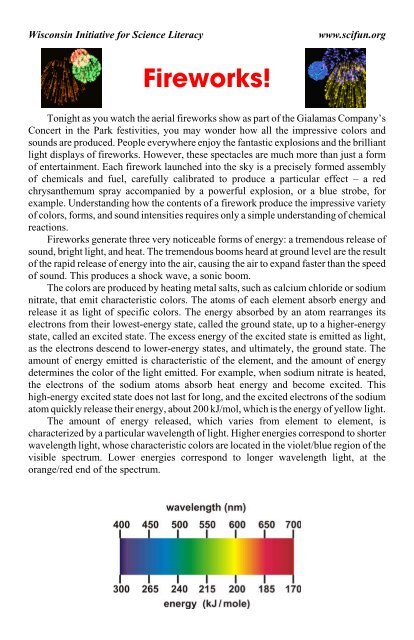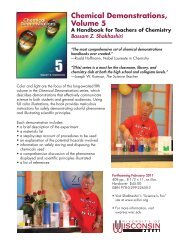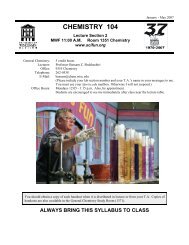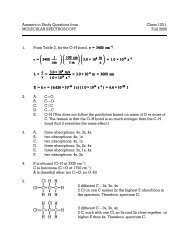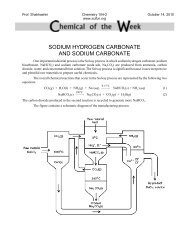Fireworks! - Science is Fun in the Lab of Shakhashiri - University of ...
Fireworks! - Science is Fun in the Lab of Shakhashiri - University of ...
Fireworks! - Science is Fun in the Lab of Shakhashiri - University of ...
Create successful ePaper yourself
Turn your PDF publications into a flip-book with our unique Google optimized e-Paper software.
W<strong>is</strong>cons<strong>in</strong> Initiative for <strong>Science</strong> Literacy<br />
www.scifun.org<br />
<strong>Fireworks</strong>!<br />
Tonight as you watch <strong>the</strong> aerial fireworks show as part <strong>of</strong> <strong>the</strong> Gialamas Company’s<br />
Concert <strong>in</strong> <strong>the</strong> Park festivities, you may wonder how all <strong>the</strong> impressive colors and<br />
sounds are produced. People everywhere enjoy <strong>the</strong> fantastic explosions and <strong>the</strong> brilliant<br />
light d<strong>is</strong>plays <strong>of</strong> fireworks. However, <strong>the</strong>se spectacles are much more than just a form<br />
<strong>of</strong> enterta<strong>in</strong>ment. Each firework launched <strong>in</strong>to <strong>the</strong> sky <strong>is</strong> a prec<strong>is</strong>ely formed assembly<br />
<strong>of</strong> chemicals and fuel, carefully calibrated to produce a particular effect – a red<br />
chrysan<strong>the</strong>mum spray accompanied by a powerful explosion, or a blue strobe, for<br />
example. Understand<strong>in</strong>g how <strong>the</strong> contents <strong>of</strong> a firework produce <strong>the</strong> impressive variety<br />
<strong>of</strong> colors, forms, and sound <strong>in</strong>tensities requires only a simple understand<strong>in</strong>g <strong>of</strong> chemical<br />
reactions.<br />
<strong>Fireworks</strong> generate three very noticeable forms <strong>of</strong> energy: a tremendous release <strong>of</strong><br />
sound, bright light, and heat. The tremendous booms heard at ground level are <strong>the</strong> result<br />
<strong>of</strong> <strong>the</strong> rapid release <strong>of</strong> energy <strong>in</strong>to <strong>the</strong> air, caus<strong>in</strong>g <strong>the</strong> air to expand faster than <strong>the</strong> speed<br />
<strong>of</strong> sound. Th<strong>is</strong> produces a shock wave, a sonic boom.<br />
The colors are produced by heat<strong>in</strong>g metal salts, such as calcium chloride or sodium<br />
nitrate, that emit character<strong>is</strong>tic colors. The atoms <strong>of</strong> each element absorb energy and<br />
release it as light <strong>of</strong> specific colors. The energy absorbed by an atom rearranges its<br />
electrons from <strong>the</strong>ir lowest-energy state, called <strong>the</strong> ground state, up to a higher-energy<br />
state, called an excited state. The excess energy <strong>of</strong> <strong>the</strong> excited state <strong>is</strong> emitted as light,<br />
as <strong>the</strong> electrons descend to lower-energy states, and ultimately, <strong>the</strong> ground state. The<br />
amount <strong>of</strong> energy emitted <strong>is</strong> character<strong>is</strong>tic <strong>of</strong> <strong>the</strong> element, and <strong>the</strong> amount <strong>of</strong> energy<br />
determ<strong>in</strong>es <strong>the</strong> color <strong>of</strong> <strong>the</strong> light emitted. For example, when sodium nitrate <strong>is</strong> heated,<br />
<strong>the</strong> electrons <strong>of</strong> <strong>the</strong> sodium atoms absorb heat energy and become excited. Th<strong>is</strong><br />
high-energy excited state does not last for long, and <strong>the</strong> excited electrons <strong>of</strong> <strong>the</strong> sodium<br />
atom quickly release <strong>the</strong>ir energy, about 200 kJ/mol, which <strong>is</strong> <strong>the</strong> energy <strong>of</strong> yellow light.<br />
The amount <strong>of</strong> energy released, which varies from element to element, <strong>is</strong><br />
characterized by a particular wavelength <strong>of</strong> light. Higher energies correspond to shorter<br />
wavelength light, whose character<strong>is</strong>tic colors are located <strong>in</strong> <strong>the</strong> violet/blue region <strong>of</strong> <strong>the</strong><br />
v<strong>is</strong>ible spectrum. Lower energies correspond to longer wavelength light, at <strong>the</strong><br />
orange/red end <strong>of</strong> <strong>the</strong> spectrum.
The colors you see explod<strong>in</strong>g <strong>in</strong> <strong>the</strong> sky are produced by <strong>the</strong> elements with <strong>the</strong><br />
character<strong>is</strong>tic em<strong>is</strong>sions l<strong>is</strong>ted <strong>in</strong> <strong>the</strong> follow<strong>in</strong>g table. In mak<strong>in</strong>g fireworks, <strong>the</strong> metal<br />
salts are put <strong>in</strong>to stars, small clay or dough-like lumps or cubes 3 to 4 cm <strong>in</strong> diameter.<br />
Stars cons<strong>is</strong>t <strong>of</strong> a blend <strong>of</strong> oxidiz<strong>in</strong>g agent, reduc<strong>in</strong>g agent, color<strong>in</strong>g agent (metal salt),<br />
and b<strong>in</strong>ders. When ignited, <strong>the</strong> stars produce both sound and light effects. The<br />
appearance <strong>of</strong> a firework <strong>is</strong> determ<strong>in</strong>ed by its stars, which are made by hand and<br />
carefully packed <strong>in</strong>to cardboard compartments with<strong>in</strong> <strong>the</strong> firework shell, where <strong>the</strong>y<br />
await ignition by a time-delay fuse.<br />
From lift-<strong>of</strong>f to color release, a carefully choreographed sequence <strong>of</strong> events takes<br />
place, produc<strong>in</strong>g <strong>the</strong> desired effect. The power needed to lift each firework <strong>in</strong>to <strong>the</strong> air<br />
<strong>is</strong> provided by <strong>the</strong> highly exo<strong>the</strong>rmic combustion <strong>of</strong> black powder, a slow-burn<strong>in</strong>g<br />
comb<strong>in</strong>ation <strong>of</strong> 75% potassium nitrate, 15% charcoal, and 10% sulfur. Said to have first<br />
been used <strong>in</strong> Ch<strong>in</strong>a about 1000 years ago, <strong>the</strong> recipe for black (or coal) powder has<br />
undergone little change s<strong>in</strong>ce <strong>the</strong>n. Th<strong>is</strong> formulation explodes at a rate <strong>of</strong> about 3 meters<br />
per second, classify<strong>in</strong>g it as a low explosive. In fact, when it burns <strong>in</strong> <strong>the</strong> open air, black<br />
powder’s heat and gas d<strong>is</strong>sipate quickly. The key to firework’s success <strong>is</strong> to trap <strong>the</strong> heat<br />
and gas <strong>in</strong> <strong>the</strong> bottom <strong>of</strong> <strong>the</strong> shell, which <strong>is</strong> positioned <strong>in</strong> a launch tube or mortar, until<br />
<strong>the</strong> trapped gas pressure builds to such a force that, when it escapes, it hurls <strong>the</strong> firework<br />
high <strong>in</strong>to <strong>the</strong> air.<br />
A firework <strong>is</strong> ignited by light<strong>in</strong>g <strong>the</strong> ma<strong>in</strong> fuse. That simultaneously starts both <strong>the</strong><br />
Color<br />
red<br />
Compound<br />
strontium salts, lithium salts<br />
lithium carbonate, Li 2 CO 3 = deep red<br />
strontium carbonate, SrCO 3 = bright red<br />
Wavelength<br />
(nm)<br />
650<br />
orange<br />
calcium salts<br />
calcium chloride, CaCl 2<br />
670<br />
yellow<br />
sodium salts<br />
sodium chloride, NaCl<br />
610-620<br />
green<br />
barium compounds + chlor<strong>in</strong>e producer<br />
barium chloride, BaCl 2<br />
590<br />
blue<br />
copper compounds + chlor<strong>in</strong>e producer<br />
copper(I) chloride, CuCl<br />
500-535<br />
purple<br />
mixture <strong>of</strong> strontium (red) and<br />
copper (blue) compounds<br />
420-460<br />
silver<br />
burn<strong>in</strong>g metallic alum<strong>in</strong>um,<br />
titanium, or magnesium<br />
all
fast action fuse, which quickly carries <strong>the</strong> flame down to <strong>the</strong> lift charge, and <strong>the</strong> time<br />
delay fuse, which cont<strong>in</strong>ues to burn upward toward <strong>the</strong> cardboard compartments<br />
conta<strong>in</strong><strong>in</strong>g <strong>the</strong> stars, even as <strong>the</strong> firework <strong>is</strong> hurtl<strong>in</strong>g skyward.<br />
<strong>Fireworks</strong> are classified as both a low and a high explosive. The <strong>in</strong>itial lift charge<br />
that sends <strong>the</strong> firework <strong>in</strong>to <strong>the</strong> sky <strong>is</strong> a low explosive. The burn<strong>in</strong>g charge undergoes<br />
rapid decomposition, but not detonation. The firework can be thought <strong>of</strong> as fly<strong>in</strong>g<br />
through <strong>the</strong> air powered by a fast burn<strong>in</strong>g wick. Where <strong>the</strong> wick ends, it meets <strong>the</strong> high<br />
explosive components <strong>of</strong> <strong>the</strong> firework. In th<strong>is</strong> second stage <strong>the</strong>re <strong>is</strong> an <strong>in</strong>stantaneous<br />
detonation produc<strong>in</strong>g both a loud explosion and a bright flash <strong>of</strong> color.<br />
The black powder lift-charge <strong>is</strong> calculated to exhaust itself prec<strong>is</strong>ely when <strong>the</strong><br />
slow-burn<strong>in</strong>g, time-delay fuse reaches <strong>the</strong> first compartment packed with<br />
light-produc<strong>in</strong>g stars and black powder. Th<strong>is</strong> happens when <strong>the</strong> firework <strong>is</strong> at <strong>the</strong> very<br />
apex <strong>of</strong> its upward flight. Simultaneously <strong>the</strong> fuse sets <strong>of</strong>f sound-produc<strong>in</strong>g explosives<br />
and detonates <strong>the</strong> stars, <strong>in</strong>itiat<strong>in</strong>g color em<strong>is</strong>sion. If <strong>the</strong> tim<strong>in</strong>g <strong>of</strong> <strong>the</strong> fuses <strong>is</strong> <strong>of</strong>f,<br />
however, <strong>the</strong> firework may detonate early, too close to <strong>the</strong> ground, or late, when <strong>the</strong><br />
firework <strong>is</strong> fall<strong>in</strong>g back to earth.<br />
Chem<strong>is</strong>try <strong>of</strong> <strong>Fireworks</strong><br />
The sights and sounds <strong>of</strong> each explosion are <strong>the</strong> result <strong>of</strong> several chemical reactions<br />
– oxidations and reductions – tak<strong>in</strong>g place with<strong>in</strong> <strong>the</strong> firework as it ascends <strong>in</strong>to <strong>the</strong> sky.<br />
Oxidizers produce <strong>the</strong> oxygen required to burn <strong>the</strong> mixture <strong>of</strong> reduc<strong>in</strong>g agents and to<br />
excite <strong>the</strong> atoms <strong>of</strong> <strong>the</strong> light-emitt<strong>in</strong>g compounds. Various oxidizers are used <strong>in</strong> both <strong>the</strong><br />
black powder and <strong>the</strong> stars. Commonly used oxidizers are nitrates, chlorates, and<br />
perchlorates. The reduc<strong>in</strong>g agents, sulfur and carbon, comb<strong>in</strong>e with <strong>the</strong> oxygen from <strong>the</strong><br />
oxidizers to produce <strong>the</strong> energy <strong>of</strong> <strong>the</strong> explosion.<br />
The most commonly used oxidizers are nitrates, <strong>the</strong> major component <strong>of</strong> black<br />
powder. Nitrates are composed <strong>of</strong> nitrate ions (NO – 3 ) with metal ions. The most common<br />
oxidizer <strong>is</strong> potassium nitrate, which decomposes to potassium oxide, nitrogen gas, and<br />
oxygen gas.<br />
2 KNO 3 xxv K 2 O + N 2 + 2.5 O 2<br />
When react<strong>in</strong>g, nitrates release two <strong>of</strong> <strong>the</strong>ir three oxygen atoms. Because <strong>the</strong> oxidation<br />
does not result <strong>in</strong> <strong>the</strong> release <strong>of</strong> all available oxygen, <strong>the</strong> reaction <strong>is</strong> not as vigorous as<br />
that <strong>of</strong> o<strong>the</strong>r oxidizers and <strong>is</strong> more controlled. Th<strong>is</strong> <strong>is</strong> why nitrates are used as <strong>the</strong> major<br />
component <strong>of</strong> black powder. In fireworks <strong>the</strong>ir ma<strong>in</strong> purpose <strong>is</strong> to provide <strong>the</strong> <strong>in</strong>itial<br />
thrust to power <strong>the</strong> package <strong>in</strong>to <strong>the</strong> sky and to ignite each bundle <strong>of</strong> stars. Instead <strong>of</strong><br />
nitrates, chlorates or perchlorates are usually used <strong>in</strong> star explosions, because <strong>the</strong>ir<br />
reactions produce a temperature high enough to energize many <strong>of</strong> <strong>the</strong> more colorful<br />
metal salts.<br />
The oxygen released by nitrates and o<strong>the</strong>r oxidizers <strong>in</strong> <strong>the</strong> star compartments<br />
immediately comb<strong>in</strong>es with <strong>the</strong> reduc<strong>in</strong>g agents to produce hot, rapidly expand<strong>in</strong>g<br />
gasses. The most common reduc<strong>in</strong>g agents are sulfur and carbon (charcoal) – standard<br />
components <strong>of</strong> black powder – which react with oxygen to produce sulfur dioxide and<br />
carbon dioxide respectively:<br />
O 2 (g) + S(s) xxv SO 2 (g)<br />
O 2 (g) + C(s) xxv CO 2 (g)
The reactions that produce <strong>the</strong>se gases also release a great deal <strong>of</strong> heat energy, so no<br />
only are <strong>the</strong> gases produced rapidly, <strong>the</strong>y are hot and rapidly expand<strong>in</strong>g gases. Th<strong>is</strong> adds<br />
to <strong>the</strong> explosive force <strong>of</strong> <strong>the</strong> reaction.<br />
Firework Safety<br />
<strong>Fireworks</strong> are used so frequently today <strong>in</strong> celebrations that it <strong>is</strong> easy to forget that<br />
<strong>the</strong>y are dangerous explosives. Every year more than 8,000 people <strong>in</strong> <strong>the</strong> U.S. suffer<br />
<strong>in</strong>juries caused by <strong>the</strong> personal use <strong>of</strong> fireworks. Nearly half <strong>of</strong> <strong>the</strong> victims are children.<br />
A third <strong>of</strong> <strong>the</strong> <strong>in</strong>juries are caused by illegally obta<strong>in</strong>ed fireworks, and burns account for<br />
half <strong>the</strong> <strong>in</strong>juries. (An ord<strong>in</strong>ary sparkler burns at a temperature <strong>of</strong> more than 1000°C!)<br />
The National Fire Protection Association ( www.nfpa.org ) enforces str<strong>in</strong>gent safety<br />
regulations for large fireworks d<strong>is</strong>plays. Spectators must be kept at least 840 feet from<br />
<strong>the</strong> launch area (that's based on <strong>the</strong> height and burst diameter <strong>of</strong> <strong>the</strong> largest shells).<br />
Shells may not be launched if w<strong>in</strong>ds are stronger than 20 miles per hour, because <strong>the</strong>y<br />
could be blown <strong>of</strong>f course. Never<strong>the</strong>less, many accidents occur with unregulated,<br />
<strong>in</strong>formal neighborhood d<strong>is</strong>plays, when spectators attracted to <strong>the</strong> activities stand<br />
dangerously close to <strong>the</strong> launch area.<br />
<strong>Fireworks</strong> manufacturers also go to great lengths to ensure safety, but even so, more<br />
than 20 workers were killed <strong>in</strong> firework plants <strong>in</strong> <strong>the</strong> U.S. between 1970 and 1995.<br />
Safety regulations require that build<strong>in</strong>gs be separated by concrete blast walls and that<br />
ro<strong>of</strong>s be weakened to ensure that any explosion travels upwards ra<strong>the</strong>r than outwards.<br />
In addition, most fireworks are still made by hand because metal mach<strong>in</strong>ery could<br />
produce sparks or static electricity which would ignite <strong>the</strong> explosives.<br />
Many animals are terrorized by <strong>the</strong> no<strong>is</strong>e <strong>of</strong> fireworks, and people are urged to leave<br />
<strong>the</strong>ir pets at home when <strong>the</strong>y go to fireworks d<strong>is</strong>plays. Sadly, <strong>the</strong>re are reports <strong>of</strong> dogs<br />
that have run away from <strong>the</strong> no<strong>is</strong>e, and some were lost.<br />
W<strong>is</strong>cons<strong>in</strong> Initiative for <strong>Science</strong> Literacy<br />
The W<strong>is</strong>cons<strong>in</strong> Initiative for <strong>Science</strong> Literacy <strong>is</strong> a national <strong>in</strong>itiative headquartered<br />
at <strong>the</strong> <strong>University</strong> <strong>of</strong> W<strong>is</strong>cons<strong>in</strong>-Mad<strong>is</strong>on. Our two goals are<br />
• to promote literacy <strong>in</strong> science, ma<strong>the</strong>matics, and technology among <strong>the</strong> general<br />
public, and<br />
• to attract future generations to careers <strong>in</strong> research, teach<strong>in</strong>g, and public science.<br />
Our programs <strong>in</strong>clude:<br />
• <strong>Science</strong> Is <strong>Fun</strong>!<br />
• <strong>Science</strong>, Arts, and Humanities<br />
• Women <strong>in</strong> <strong>Science</strong><br />
• Conversations <strong>in</strong> <strong>Science</strong> Series<br />
• Capitol <strong>Science</strong><br />
• <strong>Science</strong> on <strong>the</strong> Radio<br />
• Once Upon a Chr<strong>is</strong>tmas Cheery<br />
• <strong>Science</strong>, Religion, Politics, and Ethics<br />
<strong>in</strong> <strong>the</strong> <strong>Lab</strong> <strong>of</strong> <strong>Shakhashiri</strong><br />
For more <strong>in</strong>formation, please v<strong>is</strong>it our web site:<br />
www.scifun.org


